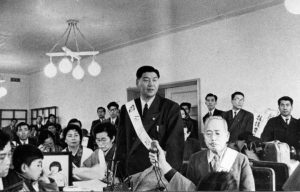Documenting Hiroshima 80 years after A-bombing: March 20, 1956, petition made to parliamentary Diet
Mar. 21, 2025
Direct petition seeking free medical care for survivors of atomic bombing
by Michio Shimotaka, Staff Writer
On the morning of March 20, 1956, around 40 sufferers of the atomic bombing arrived at Tokyo Station, after having departing from Hiroshima Station by express train the previous day. Seven months had passed since the first World Conference against Atomic and Hydrogen Bombs was held in Hiroshima. March 20 had been designated “Diet Petition Day” by the Japan Council against Atomic and Hydrogen Bombs, an organization established the month after the conference was held. The group of A-bomb sufferers went to Tokyo to make a direct appeal themselves for support.
Lasting hopes
At Tokyo Station, packed with members of the media, the group’s leader, Heiichi Fuji, 40 at the time, delivered his remarks. “At our backs are the lasting hopes of 290,000 people who continue to suffer the consequences of A-bomb diseases and 300,000 victims resting in the ground.”
Mr. Fujii served as secretary-general of an A-bomb sufferers relief committee, devoting himself to the work of organizing A-bomb victims. On March 18, two days before the visit to Tokyo, he worked to realize the first conference of A-bomb sufferers after calling for participation from throughout Hiroshima Prefecture. Around 300 people joined the conference, which was held at Senda Elementary School (in Hiroshima’s present-day Naka Ward), and decided on the details of the petition.
One of the relief measures the conference members proposed for the petition was full compensation by the national government for medical treatment expenses for survivors. Even as survivors experienced the atomic bombing resulting from the war started by the national government and suffered from “A-bomb diseases” such as leukemia, there was no system in place for the national government to take responsibility for medical treatment. The burden of medical expenses was similar to pouring salt on a wound. The petition therefore called for establishment of the Atomic Bomb Survivors Relief Law Bill (tentative name), which was to include health management for survivors, who worried about the development of disease in the future.
On March 20, the delegation from Hiroshima, holding a photograph of the late Sadako Sasaki, a young girl who had died of leukemia 10 years after she experienced the atomic bombing, met with the speakers of both the House of Representatives and the House of Councilors, at which time they submitted the written petition. The group also made the same requests of then Prime Minister Ichiro Hatoyama. The next day, the group visited the home of Hayato Ikeda, then a member of the House of Representatives elected from Hiroshima, who would become the prime minister of Japan four years later.
Shizuko Abe, 98, one of the participants in the petition event who now lives in Hiroshima’s Minami Ward, spoke of the tragic reality she and people like her had faced since the atomic bombing in their meeting with Mr. Ikeda. He seemed to listen carefully, but after the meeting concluded, he uttered a piercing comment. “Japan is in a weak position when it comes to the United States,” he said.
Advice for promoting establishment of organization
Ms. Abe recalled that experience from the perspective of today. “I was sad to hear the comment, with the realization that the Japanese national government had left us alone for 10 long years without offering any help simply because it was worried about the attitude of the nation that damaged us,” said Ms. Abe. However, she added, “Mr. Ikeda granted us his insight” when “he told us that individual appeals lacked influence, advising that we form an organization and visit him again.”
Upon returning to her home, where she was living at the time in the present-day town of Kaita-cho, she would walk around the town night after night with Masuto Higaki, who had lost his wife and daughter in the atomic bombing and died in 1990 at the age of 94, compiling a list of names of local A-bomb sufferers, which led to the formation of an A-bomb sufferers association in Kaita-cho.
At the same time, unification and solidarity among A-bomb survivors organizations across Hiroshima Prefecture was making progress. In Hiroshima City alone several groups had formed, including the Atomic Bomb Survivors Association and the Friends of August 6. Local A-bomb sufferers associations had also been formed in the northern and eastern parts of the prefecture. On May 27, under the leadership of Mr. Fujii, a conference was held at the YMCA auditorium in the area of Motomachi (in Hiroshima’s present-day Naka Ward) with the aim of bringing all the groups into a new organization.
The new organization was named the Hiroshima Prefectural Confederation of A-bomb Sufferers Organizations (Hiroshima Hidankyo). At the conference venue, with around 120 people in attendance such as representatives from local survivors’ groups, there were hung banners reading “Promote movement to ban atomic and hydrogen bombs” and “Seek national compensation for victims of atomic and hydrogen bombs.” Organizational policies including the aim of enacting the Atomic Bomb Survivors Relief Law Bill were decided at the conference.
A-bomb sufferers participated in the conference from Ehime Prefecture, which already had a prefectural organization, and Nagasaki Prefecture, which was expected to form a local prefectural organization in June. The participants discussed the creation of the Association of Japan A-and H-Bomb Sufferers Organizations (tentative name) and agreed on a policy to implement a campaign for the sufferers from the four prefectures, including Nagano Prefecture. In August, a more developed, nationwide A-bomb sufferers organization was established.
(Originally published on March 21, 2025)








